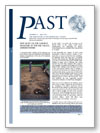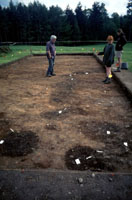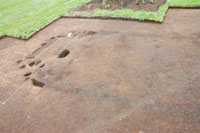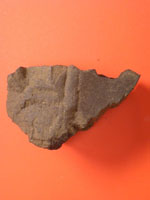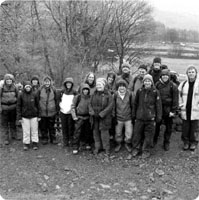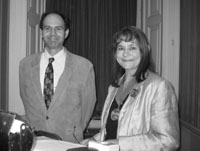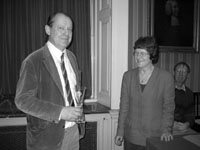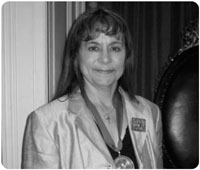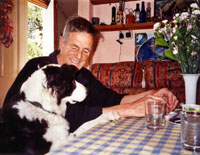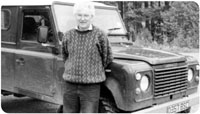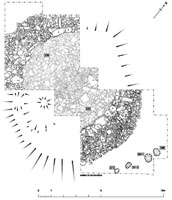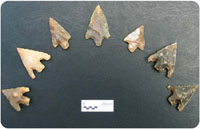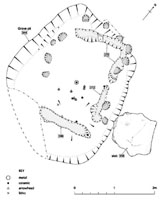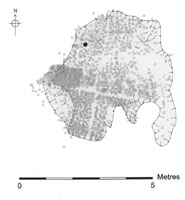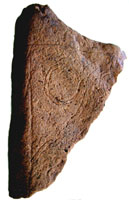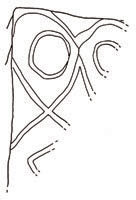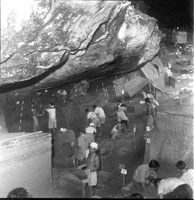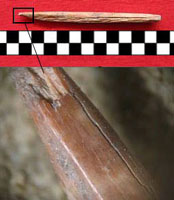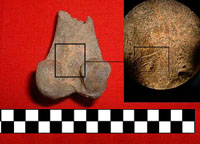|

Figure 1: Long Meg 3D laser scanner data coloured according to relative
elevation.
|
For more than a century, the documentation of most British prehistoric rock art
has been undertaken by a small number of antiquarians and avocational
archaeologists including James Simpson (1865), Ronald Morris (1981) and, more
recently, Stan Beckensall (1999) and the Ilkley Archaeology Group (Boughey
& Vickerman 2003). Techniques used to record the carvings have varied from
tracing, free-hand drawing, to photography and wax rubbing, the latter being
that most commonly used during the last three decades. Although these
approaches provide adequate information to identify each carving and give an
impression of the designs, they cannot reproduce the degree of detail and
accuracy required by today’s researchers and conservationists. The traditional
techniques are inherently subjective; they rely heavily on the skill and
experience of the recorder as well as on prevailing lighting conditions. The
process of transferring a 3D object onto a 2D piece of paper also has obvious
limitations. Even the most experienced protagonists acknowledge that repeated
visits to the same site may produce different results. 3D laser scanning has
the potential to revolutionise rock art recording. It produces highly objective
and accurate 3D models providing reliable, detailed information for both
researchers and conservationists. Laser recordings may even identify previously
unknown carvings, as demonstrated by recent discoveries at Stonehenge (Goskar
et al.2003).
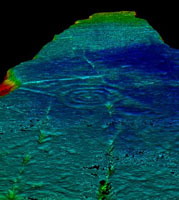
Figure 2: Perspective view of Long Meg laser scanner data using absolute
elevation rendering relative to the average rock face plane. The dark region
has a higher elevation than the top and bottom region of the face.
|
The project “Breaking through rock art recording: three dimensional laser
scanning of megalithic rock art”, sponsored by the Arts and Humanities Research
Board (now the Arts and Humanities Research Council) under the Innovation
Awards scheme, aimed to explore the potential of this novel technique. The one
year project was undertaken by the University of Durham, led by Margarita
Díaz-Andreu, and began in March 2004. The main sites analysed were the stone
circle at Castlerigg and the standing stone of Long Meg in Cumbria, in addition
to the Copt Howe panel, also in Cumbria, and the Horseshoe Rock site in
Northumberland where an investigation on 3D representations had been previously
undertaken (Simpson et al. 2004; Trinks et al. forthcoming). This article
focuses on the results obtained at Long Meg (NY56933716, CCSMR6154, NMR 23663),
comparing two different methods to visualise the rock art data, one developed
by Hobbs and Trinks using freely available software, and the other one
undertaken by Nick Rosser employing software especially developed for
archaeology by Archaeoptics Ltd but no longer commercially available unless the
Archaeoptics laser scanning service is also purchased. Two previous recordings
existed of the carvings on the western face of the pillar: an early recording
first published in 1867 by Simpson in the form of a lithograph by A. Ritchie
(Simpson 1867, plate VII), and a wax rubbing produced by Beckensall (2002, fig.
70).
The recording of Long Meg with 3D laser scanning was undertaken
in several phases. The first phase included the laser scanning and
pre-processing of data. This was undertaken by a team led by Dr Alan Chalmers,
University of Bristol. The data set acquired with a Minolta 910 laser scanner
consisted of roughly 45 million points (26 million of which came from the
north-easterly facing panel where the carvings are located), with overlaps in
excess of 25% between the coverage of each scan. The recording took
approximately twelve hours and involved the creation of 102 ‘patches’ of rock
surface which were then ‘stitched’ together electronically to create the
complete 3D model.
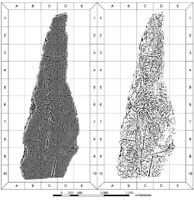
Figure 3: Left – front face of Long Meg, showing the result of the high-pass
convolution filter. The grey scales indicate the degree of surface indentation,
with black areas showing the deepest cuts. Right – shows the result of the
threshold filter applied to the processed surface image. The threshold removes
noise from the surface topography and identifies significant features.
|
The second phase was the development of new processing and 3D visualisation
methods to visualize the rock art contained in the data. This was undertaken by
two different approaches. A new method was developed by Immo Trinks and Richard
Hobbs of the Department of Earth Sciences at the University of Durham using the
Visualization Toolkit (VTK) and Generic Mapping Tools (GMT) software. The
original data was resampled to 645,432 points since the overlapping scan areas
contained a large amount of redundant information. The carved front face of
Long Meg was transformed into horizontal orientation and the data points were
gridded using a 2D triangulation algorithm (Wessel & Smith 1991).
Subsequently a spatial high pass frequency filter was applied to the 3D surface
data, removing the long-wavelength surface structure of the rock (Trinks et al.
forthcoming). Thus, the relative local elevation could be rendered using colour
intensity values (Fig. 1). Figure 2 shows that elevation rendering without the
removal of the low-frequency content, which represents the large-scale
topography of the rock, would fail to highlight the rock carvings. It is
possible to map the relative elevation colour values onto a digital 3D rock
model, in order to visualize small scale variations in the rock surface. This
option is particularly interesting should the rock have strong 3D structure.
Due to the relatively plane structure of the front face of Long Meg (Fig. 2)
this step was not considered necessary.
A second method of visualising the data was undertaken by Nick
Rosser, Geography Department, University of Durham. Data was processed using
firstly Demon3D (Archaeoptics Ltd) and then ENVI RT 4.0(RSI). The initial stage
of the processing involved trimming the point cloud of the data beyond the area
of interest to reduce data processing time. The point cloud was then
triangulated using a 2.5 dimension view dependant triangulation algorithm. This
was conducted from a view angle which was normal to the dominant plane of the
rock face. The triangulated surface was edited, with long triangles removed to
reduce interpolative errors on the surface. The meshed surface was then
rendered and light from 3 directions applied to enhance the differentiation of
surface texture and features for visualisation. The second stage of the data
processing involved the detection of surface features. Given the curvature of
the rock face a simple contour or height rendering does not represent the
surface detail well.
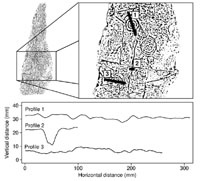
Figure 4: Top – diagram showing the location of profiles 1, 2 and 3 on the
carved face of Long Meg. Bottom – graphs showing the three profiles extracted:
1) well defined human made carving; 2) natural rock fracture; and 3) degraded
human made carving.
|
To overcome this, remote sensing image analysis techniques were applied, using
ENVIRT 4.0 (RSI). The edited point cloud data from Demon3D was imported into
ENVI, and gridded at 0.0005 m resolution, which derived a raster of the rock
surface topography. A high pass convolution filter with kernel width 29 mm was
then applied to the image to remove long wavelength surface curvature, but
retain surface detail (Fig. 3 left). This kernel size was found to remove the
general rock surface topography but maintain surface detail well. A
triangulation threshold algorithm was then applied to the resulting image. The
level of the threshold revealed different levels of detail on the image and was
tailored to filter out noise (Fig.3 right). Three profiles cut vertically
through the surface were extracted using Demon3D (Fig. 4). Profile1 illustrates
profiles across a human made carving, where the carved grooves have a rounded
cross sectional form but are distinct indentations on the profile. Profile 2
shows a natural fracture, which is deeper, weathered, and non-symmetrical.
Profile 3 shows a weathered carved surface, and here it is noticeable that the
surface definition is less clear than that seen in Profiles 1 and 2, with less
differentiation between the carved grooves and surrounding surface.
The results of the analysis of 3D laser scanning data
demonstrate the power of the technique to capture the features accurately and
objectively. Both methods have provided very similar results. In order to
describe them we have superimposed the image with a grid (Fig. 3). Because of
the limitation in the number of words, a detailed description is not possible
here. In brief, our recording has identified three certain cup and ring motifs
and one spiral and another five possible cup and ring motifs. The first are
located, from top to bottom and left to right, in 45C, 67C and 9B and the
spiral in 78CD. The possible cup and ring motifs are placed in6CD, 78BC, D7,
89C, 910B. There may be some evidence of a circular motif in 34D. There seems
to be some evidence of the loops recorded by Beckensall in 6C, but there are
not clear. The analysis of profiles taken across the surface shows distinct
differences between natural and human made surface features. Additionally,
there are considerable differences in the degree of angularity and rounding
across the ring motifs identified, which have potential to act as a measure of
the relative age of the carvings. In comparison with previous recordings, laser
scanning really represents a quantum leap in rock art recording. The technique
offers significant advantages over previous methods of recording, namely:
objectivity in recording is hugely improved in relation to traditional
techniques such as rubbing; results are reliable and reproducible; the level of
precision achieved is much greater than that obtained with any other method
currently available, including photogrammetry; and the recording process is
non-invasive and so not detrimental to fragile rock surfaces.
M. Díaz-Andreu, project leader, Department of Archaeology.
University of Durham.
R. Hobbs, Department of Earth Sciences, University of Durham.
N. Rosser, Geography Department, University of Durham.
K. Sharpe, research assistant, Department of Archaeology. University of Durham.
I. Trinks, Department of Earth Sciences, University of Durham
Acknowledgments
We are grateful to the owner of the site for permission for access.
References
Beckensall, S. 1999. British Prehistoric Rock Art. Stroud: Tempus.
Beckensall, S. 2002. Prehistoric Rock Art in Cumbria: landscapes and monuments.
Stroud: Tempus.
Boughey, K. & Vickerman, E. 2003. Prehistoric Rock Art of the West Riding:
cup-and-ring-marked rocks of the valleys of the Aire, Wharfe, Washburn and
Nidd. Leeds: West Yorkshire Archaeological Services.
Goskar, T. A., Carty, A., Cripps, P., Brayne, C. & Vickers, D.2003. The
Stonehenge Laser Show. British Archaeology 73, 9-15.
Morris, R. 1981. The Prehistoric Rock Art of Southern Scotland, except Argyll.
Oxford: British Archaeological Reports, British Series 86.
Simpson, A., Clogg, P., Díaz-Andreu, M. & Larkman, B. 2004. Towards
three-dimensional non-invasive recording of incised rock art. Antiquity
78, 692-8.
Simpson, J. Y. 1865. On ancient sculpturings of cups and concentric rings. Proceedings
of the Society of Antiquaries of Scotland 6, 1-140.
Simpson, J. Y. 1867. Archaic Sculpturings of Cups, Circles & c. upon Stones
and Rocks in Scotland, England & Other Countries. Edinburgh:
Edmonston & Douglas.
Trinks, I., Díaz-Andreu, M., Hobbs, R. & Sharpe, K. Forthcoming. Recording
rock art using 3D laser scanner data. (Submitted).
Wessel, P. & Smith, W.H.F. 1991. Free software helps map and display data. Eos
Transactions of the American Geophysical Union 72 (441), 445-446.
|
![]()
